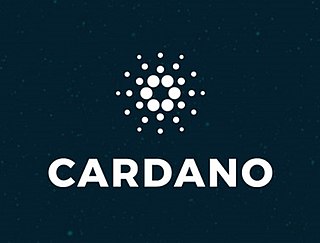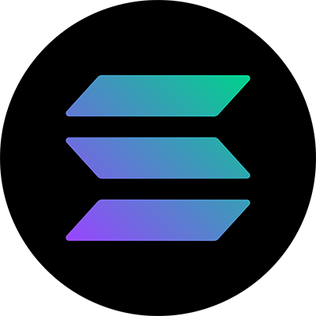Related Research Articles

Ethereum is a decentralized blockchain with smart contract functionality. Ether is the native cryptocurrency of the platform. Among cryptocurrencies, ether is second only to bitcoin in market capitalization. It is open-source software.
A decentralized autonomous organization (DAO), sometimes called a decentralized autonomous corporation (DAC), is an organization managed in whole or in part by decentralized computer program, with voting and finances handled through a blockchain. In general terms, DAOs are member-owned communities without centralized leadership. The precise legal status of this type of business organization is unclear.
Circle is a peer-to-peer payments technology company that now manages stablecoin USDC, a cryptocurrency the value of which is pegged to the U.S. dollar. It was founded by Jeremy Allaire and Sean Neville in October 2013. Circle is headquartered in Boston, Massachusetts. USDC, the second largest stablecoin worldwide, is designed to hold at or near a stable price of $1. The majority of its stablecoin collateral is held in short-term U.S. government securities.

Augur is a decentralized prediction market platform built on the Ethereum blockchain. Augur is developed by Forecast Foundation, which was founded in 2014 by Jack Peterson, Joey Krug, and Jeremy Gardner. Forecast Foundation is advised by Ron Bernstein, founder of now-defunct company Intrade, and Ethereum founder Vitalik Buterin.
A decentralised application is an application that can operate autonomously, typically through the use of smart contracts, that run on a decentralized computing, blockchain or other distributed ledger system. Like traditional applications, DApps provide some function or utility to its users. However, unlike traditional applications, DApps operate without human intervention and are not owned by any one entity, rather DApps distribute tokens that represent ownership. These tokens are distributed according to a programmed algorithm to the users of the system, diluting ownership and control of the DApp. Without any one entity controlling the system, the application is therefore decentralised.

Cardano is a public blockchain platform. It is open-source and decentralized, with consensus achieved using proof of stake. It can facilitate peer-to-peer transactions with its internal cryptocurrency, ADA.
Tether is a cryptocurrency stablecoin, launched by the company Tether Limited Inc. in 2014. As of January 2024, Tether's website lists fourteen protocols and blockchains on which Tether has been minted.
A cryptocurrency bubble is a phenomenon where the market increasingly considers the going price of cryptocurrency assets to be inflated against their hypothetical value. The history of cryptocurrency has been marked by several speculative bubbles.
A stablecoin is a type of cryptocurrency where the value of the digital asset is supposed to be pegged to a reference asset, which is either fiat money, exchange-traded commodities, or another cryptocurrency.
Cryptoeconomics is an evolving economic paradigm for a cross-disciplinary approach to the study of digital economies and decentralized finance (DeFi) applications. Cryptoeconomics integrates concepts and principles from traditional economics, cryptography, computer science, and game theory disciplines. Just as traditional economics provides a theoretical foundation for traditional financial services, cryptoeconomics provides a theoretical foundation for DeFi services bought and sold via fiat cryptocurrencies, and executed by smart contracts.

TRON is a decentralized, blockchain-based operating system with smart contract functionality, proof-of-stake principles as its consensus algorithm and a cryptocurrency native to the system, known as Tronix (TRX). It was established in March 2014 by Justin Sun and since 2017 has been overseen and supervised by the TRON Foundation, a non-profit organization in Singapore, established in the same year. It is open-source software.
USD Coin (USDC) is a digital stablecoin pegged to the United States dollar. USD Coin is managed by Circle. USDC is issued by a private entity and should not be confused with a central bank digital currency (CBDC).
Decentralized finance offers financial instruments without relying on intermediaries such as brokerages, exchanges, or banks by using smart contracts on a blockchain, mainly Ethereum. DeFi platforms allow people to lend or borrow funds from others, speculate on price movements on assets using derivatives, trade cryptocurrencies, insure against risks, and earn interest in savings-like accounts. DeFi uses a layered architecture and highly composable building blocks. Some applications promote high-interest rates but are subject to high risk. Coding errors and hacks have been common in DeFi.

Dai is a stablecoin token on the Ethereum blockchain which uses smart contracts designed to control supply to keep its value as close to one United States dollar as possible. Dai is maintained and regulated by MakerDAO, a decentralized autonomous organization composed of the owners of its governance token, MKR, who may propose and vote on changes to certain parameters in its smart contracts.

Uniswap is a decentralized cryptocurrency exchange that uses a set of smart contracts to create liquidity pools for the execution of trades. It is an open source project and falls into the category of a DeFi product because it uses smart contracts to facilitate trades instead of a centralized exchange. The protocol facilitates automated transactions between cryptocurrency tokens on the Ethereum blockchain through the use of smart contracts. As of October 2020, Uniswap was estimated to be the largest decentralized exchange and the fourth-largest cryptocurrency exchange overall by daily trading volume.

0x is an open-source, decentralized exchange infrastructure that enables the exchange of tokenized assets on multiple blockchains. Developers can use 0x to incorporate exchange functionality into their applications, and market makers can use 0x to create markets for cryptocurrencies and tokens. ZRX, an Ethereum ERC-20 token, is the native governance and staking token of 0x. Individuals who own ZRX can vote on protocol changes and stake their tokens to earn liquidity rewards in Ether (ETH). The project's creator and core developer is 0x Labs.

Solana is a blockchain platform which uses a proof-of-stake mechanism to provide smart contract functionality. Its native cryptocurrency is SOL.
Terra is a blockchain protocol and payment platform used for algorithmic stablecoins. The project was created in 2018 by Terraform Labs, a startup co-founded by Do Kwon and Daniel Shin. It was best known for its Terra stablecoin and the associated LUNA reserve asset cryptocurrency.

Polygon is a blockchain platform which aims to create a multi-chain blockchain system compatible with Ethereum. As with Ethereum, it uses a proof-of-stake consensus mechanism for processing transactions on-chain. Polygon's native token is named MATIC. Matic is an ERC-20 token, allowing for compatibility with other Ethereum cryptocurrencies. It is operated by Polygon Labs.
The Aave Protocol is an open-source, decentralized finance (DeFi) protocol built on the Ethereum blockchain and released in 2020. It is one of the largest cryptocurrency liquidity protocols. The Aave Protocol uses smart contracts to automate processes, including distributing funds and handling collateral.
References
- ↑ Chavez-Dreyfuss, Gertrude (June 26, 2019). "U.S. bitcoin ATM operator to add Dai stablecoin, launch remittance service". Reuters.com. Reuters. Archived from the original on 14 November 2020. Retrieved 14 November 2020.
- ↑ Stabile, Daniel T.; Prior, Kimberly A.; Hinkes, Andrew M. (July 31, 2020). Digital Assets and Blockchain Technology. Edward Elgar Publishing. p. 263. ISBN 9781789907445. Archived from the original on 28 May 2021. Retrieved 14 November 2020.
- ↑ "Why 'DeFi' Utopia Would Be Finance Without Financiers: QuickTake". Bloomberg.com. 2020-08-26. Retrieved 2023-08-21.
- 1 2 Haig, Samuel (2023-05-15). "MakerDAO Founder Proposes Dedicated Blockchain and New DAI and MKR Tokens - The Defiant". thedefiant.io. Retrieved 2024-06-01.
- ↑ Marsh, Alistair (October 5, 2019). "Crypto Rebels Trip Over Each Other en Route to Financial Utopia". Bloomberg.com. Bloomberg. Archived from the original on 2021-12-16. Retrieved 14 November 2020.
- ↑ "r/MakerDAO - 貸 dai ◈". reddit. Retrieved 2021-06-28.
- ↑ Hackett, Robert; Roberts, Jeff John; Wieczer, Jen (October 1, 2018). "Why Crypto's Newest Venture Capitalists Bet Millions on an Ethereum "Stablecoin"". Fortune.com. Fortune. Archived from the original on 17 November 2020. Retrieved 14 November 2020.
- ↑ Hackett, Robert; Roberts, Jeff John; Wieczer, Jen (October 1, 2018). "Why Crypto's Newest Venture Capitalists Bet Millions on an Ethereum "Stablecoin"". Fortune.com. Fortune. Archived from the original on 17 November 2020. Retrieved 14 November 2020.
- ↑ "Silicon Valley bets on crypto projects to disrupt finance". www.ft.com. Retrieved 2024-01-11.
- ↑ Wilson, Tom (November 18, 2019). "Crypto backed by crypto: Dai seeks to change 'stablecoin' game". Reuters.com. Reuters. Archived from the original on 16 November 2020. Retrieved 14 November 2020.
- ↑ "'DeFi' movement promises high interest but high risk". www.ft.com. Retrieved 2024-01-11.
- ↑ Marsh, Alistair (October 5, 2019). "Crypto Rebels Trip Over Each Other en Route to Financial Utopia". Bloomberg.com. Bloomberg. Archived from the original on 2021-12-16. Retrieved 14 November 2020.
- ↑ David Pan (18 June 2022). "DeFi Platform MakerDAO Pauses Some Aave-Related Lending Activity". Bloomberg.
- ↑ "MakerDAO Gets Existential After Tornado Ban". Bloomberg.com. 2022-09-01. Retrieved 2024-01-11.
- ↑ Muyao Shen (6 October 2022). "DeFi Protocol MakerDAO Puts $500 Million in Treasuries, Bonds". bloomberg.com.
- ↑ "MakerDAO Now Earns 80% Of Its Fee Revenue From Real-World Assets". Yahoo Finance. 2023-07-12. Retrieved 2024-01-11.
- ↑ Sidhartha Shukla (31 July 2023). "DeFi Lender Foray Into Treasuries Drives Rally in MKR Token".
- ↑ Tanzeel Akhtar et Sidhartha Shukla (29 September 2023). "Crypto's New Darling Is Ready to Deploy $6 Billion in Treasuries".
- ↑ "Vitalik Offloads MKR After MakerDAO Founder Pitches Solana Fork". Yahoo Finance. 2023-09-05. Retrieved 2024-01-11.